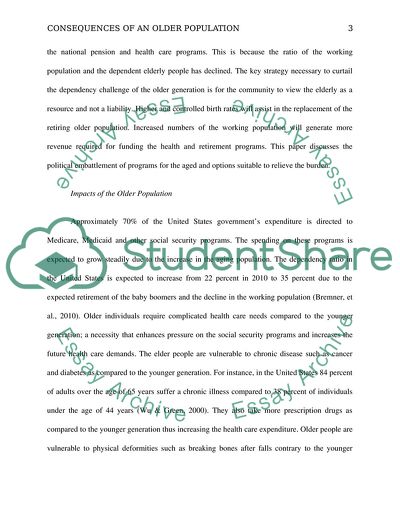Cite this document
(Consequences of an Older Population Report Example | Topics and Well Written Essays - 2250 words - 1, n.d.)
Consequences of an Older Population Report Example | Topics and Well Written Essays - 2250 words - 1. https://studentshare.org/sociology/1782781-the-consequences-of-an-older-population-issues-to-be-explored-and-discussed-include-the-possible-increased-burden-on-the-younger-population-to-compensate-for-health-care-cost-and-lost-income-housing-needs-and-a-lesser-population-contributing-to-social
Consequences of an Older Population Report Example | Topics and Well Written Essays - 2250 words - 1. https://studentshare.org/sociology/1782781-the-consequences-of-an-older-population-issues-to-be-explored-and-discussed-include-the-possible-increased-burden-on-the-younger-population-to-compensate-for-health-care-cost-and-lost-income-housing-needs-and-a-lesser-population-contributing-to-social
(Consequences of an Older Population Report Example | Topics and Well Written Essays - 2250 Words - 1)
Consequences of an Older Population Report Example | Topics and Well Written Essays - 2250 Words - 1. https://studentshare.org/sociology/1782781-the-consequences-of-an-older-population-issues-to-be-explored-and-discussed-include-the-possible-increased-burden-on-the-younger-population-to-compensate-for-health-care-cost-and-lost-income-housing-needs-and-a-lesser-population-contributing-to-social.
Consequences of an Older Population Report Example | Topics and Well Written Essays - 2250 Words - 1. https://studentshare.org/sociology/1782781-the-consequences-of-an-older-population-issues-to-be-explored-and-discussed-include-the-possible-increased-burden-on-the-younger-population-to-compensate-for-health-care-cost-and-lost-income-housing-needs-and-a-lesser-population-contributing-to-social.
“Consequences of an Older Population Report Example | Topics and Well Written Essays - 2250 Words - 1”. https://studentshare.org/sociology/1782781-the-consequences-of-an-older-population-issues-to-be-explored-and-discussed-include-the-possible-increased-burden-on-the-younger-population-to-compensate-for-health-care-cost-and-lost-income-housing-needs-and-a-lesser-population-contributing-to-social.


